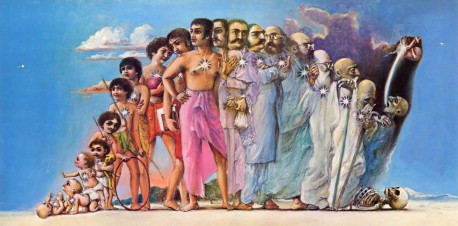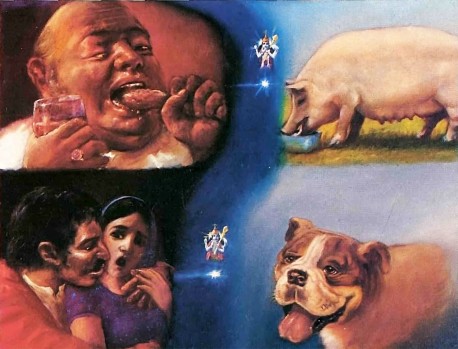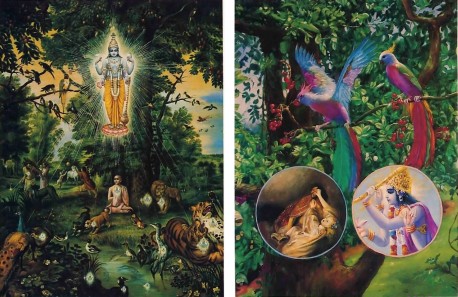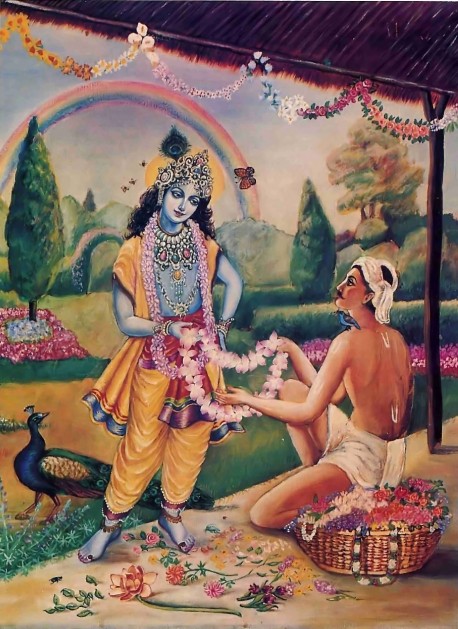by Mandaleswara dasa
“Transmigration,” “reincarnation,” “astral travel,” “life after death”—topics once hardly mentioned but now much talked about. Is there a soul? Can the soul live outside the body? What happens to the soul when the body dies? Many people have their theories, but ancient India’s Vedic literatures have the facts.

Lesson One: Each of Us Is a Living Soul Within a Material Body.
At every moment our bodies are changing. The billions of cells that are the building blocks of our bodies are continuously dying and being replaced by new cells. In this way the body that each of us had a few years ago no longer exists—our present body has replaced it. In one lifetime we actually have many different bodies—baby, child, youth, adult, and so on—but we remain the same person. We do not change our identity as the body changes, because we are not the body.
But almost every one of us thinks that he is his body, Why is that? The Vedic literatures explain that there is a spark of life within the body that animates it. This spark of life—the spiritual soul—is the real self, the real person. When encased within, say, a white male body born in America, the self thinks, “I am a white American man.” When in a black female body born in Europe, the self thinks, “I am a black European woman.” And so on. This is illusion or (in Sanskrit) maya—”that which is not.” This illusion is very strong—right from birth everyone identifies himself with his body—so we require education. We have to learn that science which comprehends not only the material body but also the soul within the body. Although such a science is not taught in any Western university, it is taught in the Vedic literatures especially in the Bhagavad-gita.
The Bhagavad-gita explains the first concept of Vedic science in this way: “As the embodied living soul continuously passes, in this body, from boyhood to youth to old age, so the same soul passes into another body at death” (Bg. 2.13). Our bodies grow and change because the living soul is present within the heart—it’s that spark of life, the soul, that makes the body alive. But when the soul leaves the body, then all physical activities cease, and the eternally living soul transmigrates to another body. This experience is known as death. In other words, even during the course of one lifetime the eternally living soul is imperceptibly moving from body to body, and “death” is simply another move—a “transmigration” to a totally new body—for the deathless, changeless soul. The Bhagavad-gita explains transmigration with an analogy: “As person puts on new garments, giving up the old ones, similarly, the soul accepts new material bodies, giving up the old and useless ones” (Bg. 2.22).
Lesson Two: The Living Souls Are Evolving Through the Species.
The Vedic literatures describe 8,400, 000 species of life: aquatics, trees and plants, insects and reptiles, birds, four-legged beasts, and human beings. The spiritual soul transmigrates from one species to the next, evolving up through the 8,400,000 forms of life until he attains a human body. The human form of life has a special significance, for only in the human form is the soul’s consciousness developed enough to understand that the body is just his encagement, and that there’s a way to free himself from that encagement. Now let’s examine how the spirit soul’s consciousness evolves and how he manifests his consciousness in various bodies.
Consciousness, an often used but rarely understood term, is actually the symptom of the spiritual soul. Or, in other words, consciousness is spiritual energy radiating from the soul—just as sunshine is material energy (heat and light) emanating from the sun. Just as the sun’s heat and light pervades the entire solar system, so the consciousness radiating from the spiritual soul within the heart pervades the entire material body. But until the soul evolves up to the human form, his consciousness is so covered that he has very little chance for self-realization—realization that the self is not the material body but the living soul within.
Here we have the actual explanation of evolution. God creates the 8,400,000 species simultaneously, and as each spiritual soul transmigrates from lower to higher species, his consciousness progressively develops. Finally he attains a human body, with keen human intelligence. So evolution does exist, but it’s an evolution of consciousness—not of species, as the Darwinists theorize.
However, just as there is evolution of consciousness, there is also devolution of consciousness. If, having evolved up to the human species, a spiritual soul misuses his human faculties, he must descend again into the lower species. Although the soul in the human form of life still identifies with his body, he can also glimpse his spiritual identity. This spiritual consciousness is like a small flame covered by a cloud of smoke. If we fan that flame by cultivating spiritual knowledge, we can rekindle the fire of pure consciousness—Krishna consciousness. To put it simply, the human form of life is a crossroads for the spiritual soul: he is free either to descend again into the darkness of lower species, or to end his torturous sojourn through repeated births and deaths by rekindling the full fire of his Krishna consciousness.

Lesson Three: Actions We Perform in the Human Body Determine Our Future Bodies.
This vast universe is filled with untold billions of eternally living spiritual souls, or sparks of life, and all of them are transmigrating from one body to the next. From the tiny one-celled amoeba to the great blue whale, from the smallest bacillus to the giant sequoia—all living organisms within our vast universe consist of two basic components the material body and the spiritual soul. The material body is a lifeless yet complex arrangement of physical elements, and the spiritual soul is actually a spark of life—a spark of the supreme life, God. Though only one ten-thousandth the tip of a hair in size, the soul animates one body after another. In some species he remains for only a few seconds, in others for as long as several thousand years. When a particular body is no longer fit for habitation, the soul leaves it and enters a seed, egg, or womb to begin developing his next body.
Does the soul’s transmigration from body to body take place in a random way, or does some higher authority supervise? In one lifetime the spiritual soul may enjoy as the lusty rogue, and in the next lifetime he may be kicked as the neighborhood dog. What determines a particular soul’s next body?
One answer given in the Bhagavad-gita is that each soul receives punishment or reward for the sinful or pious acts he performs during his human lifetime. This is known as the law of karma. Every act a human being performs is either in accord with the universal laws that God gives in the revealed scriptures, or it is contrary to those laws. God’s scriptural laws govern only those souls in the human form, because unlike the dull creatures in the lower species, the human being has sufficient intelligence to freely obey—or reject—the Lord’s scriptural instructions. However, along with that freedom comes accountability. Thus a sinful soul—one who breaks God’s laws—may be born as a dog in his next life, a pious soul may take his next birth as an aristocrat, and a self-realized soul may break free from the bonds of karma altogether and enter into the deathless spiritual world.
The Bhagavad-gita further explains that a living soul receives a particular kind of body according to his particular desires. For example, if my heart is filled with animalistic desires, then although I now possess a human body, my next body will be an animal body.
So we may think of the body either as the soul’s vehicle for expressing his material desires, or as the end result of good or bad acts the soul performed in his last human birth. Both concepts are correct. But in either case, we see that there must be a witness and controller who fulfills the particular desires of each spiritual soul, and who rewards or punishes each soul as he deserves. That witness, controller, and judge is the Supersoul.

Lesson Four: In the Human Body the Soul Can Discover the Supersoul.
Who is the Supersoul? The Bhagavad-gita says, “Besides the atomic spiritual soul, in this body there is another enjoyer—a transcendental enjoyer—who is the Lord. He is the supreme proprietor, overseer, and permitter, and He is known as the Supersoul” (Bg. 13.23). In other words, within each body there are two souls—the atomic soul (the individual spark of life) and the Supersoul (the supreme source of all life). The atomic soul and the Supersoul reside together within the heart of each and every body throughout the universe, and at the time of death the Supersoul accompanies the atomic soul to his next body. But the Supersoul is not an ordinary living entity. Only by the Supersoul’s arrangement does each atomic soul receive his proper body; only by the Supersoul’s sanction can the atomic soul fulfill his desires for happiness; and only by the Supersoul’s grace can the atomic soul think, feel, and act.

Right: This is an analogy from the Upanisads : one bird (the soul) is struggling hard to enjoy the fruits of the tree (the body), but he becomes satisfied only when he finally accepts the guidance of the friendly witnessing bird (the Supersoul, Krishna).
The Supersoul is the personal expansion of Lord Krishna, the Supreme Personality of Godhead. Whereas the atomic souls are expansions of Krishna’s spiritual energy, the Supersoul is an expansion of Krishna Himself. The atomic soul dwells within the material body, and he suffers and enjoys the various pains and pleasures arising from his particular body. But the Supersoul, although fully aware of these pains and pleasures, is aloof from them. And because He is always aloof from the changing body, the Supersoul always stays in the same situation—transcendence par excellence—whether He accompanies the atomic soul within his insect body, his dog body, or his human body.
Now, when we hear that the Supersoul is present along with the atomic soul in each body, we should not assume that there must be many millions of Supersouls. There are an unlimited number of atomic souls, but there is only one Supersoul. The Bhagavad-gita explains: “Although the Supersoul appears to be divided, He is never divided. He is situated as one” (Bg. 13.17). A good analogy is the sun with its reflections: there is one sun in the sky, but if we place thousands of waterpots on the ground, the sun will at once appear within each waterpot. Similarly, the Supersoul is a single transcendental entity, but He can expand Himself into the hearts of all living creatures.
As the constant companion of each individual atomic soul, the Supersoul fulfills the desires and awards the particular material bodies of every living entity. And He accompanies them on their course of birth, old age, disease, and death—life after life. Lord Krishna explains in the Bhagavad-gita: “One who sees the Supersoul accompanying the individual soul in all bodies, and who understands that neither the soul nor the Supersoul is every destroyed—he actually sees” (Bg. 13.28).
Now, this may seem surprising: the Supersoul—God—is always with the individual atomic souls, yet they are suffering. Why doesn’t the Lord in the heart divert the atomic souls from their suicidal course of repeated birth and death? If the Supersoul is actually our well-wisher, why doesn’t He end our suffering? The Upanisads answer with the analogy of the two birds in the tree.
Lesson Five: The Soul and the Supersoul Are like Two Birds in the Tree of the Body.
The Upanisads compare the body to a tree and the soul and Supersoul to two friendly birds sitting within the tree. The first bird (representing the atomic soul) is eating the tree’s fruits, which are of two kinds—happiness and distress. The second bird (representing the Supersoul) is self-satisfied, so He doesn’t bother with the fruits. He simply watches His friend, the first bird. Although these two birds have similar qualities and could enjoy the most pleasurable spiritual friendship, the first bird is captivated by the fruits of the tree, so he ignores the second bird. Meanwhile, the second bird is simply witnessing the activities of His friend. Though they are friends, still one is the master and the other is the servant. Because of forgetfulness of this relationship, the first bird (the atomic soul) must change from one tree to another, or from one body to another. The atomic soul is struggling very hard on the tree of the material body, but as soon as he agrees to accept the guidance of the Supersoul (represented by the friendly witnessing bird), he becomes fulfilled and free from suffering.
Unfortunately, very few souls within this material universe desire to serve the Supersoul, break free from the bonds of karma, and return home, back to the spiritual world. Although this material world is always miserable and dangerous, most people’s hearts are filled with so many desires to enjoy this world that they doom themselves to stay here. Everyone has this freedom, and the Supersoul within the heart, perceiving each spiritual soul’s desires, helps him try to enjoy the material world as he wishes, birth after birth.
Lesson Six: The Evolution of the Soul Culminates in Krishna Consciousness
As we can clearly see, the Supersoul is our dearest friend. And since the Supersoul is but an expansion of Lord Krishna, that means Krishna is our dearest friend. However, although Krishna always wants us to return to Him—to get free from the suffering we’ve been going through in one material body after anothee—He will not interfere with our minute free will. Without that freedom, we can’t develop any real love for Krishna, and without developing love for Krishna, we can’t break our attachment to things of this world and go back to the spiritual world.
It is only by surrendering to Lord Krishna and accepting His instructions that the spiritual soul can evolve to the highest state of existence—pure Krishna consciousness, pure love of God. The Bhagavad-gita explains that the soul who has attained love for Krishna does not again take birth in this material world after leaving his present body. Such a pure soul attains a spiritual body in the spiritual world.
Covered by illusion, we have been desiring and obtaining body after body in this miserable material world. Now, if we awaken our spiritual desires, our love for Krishna, He will award us an eternal spiritual body in the spiritual world. The spiritual world has none of the disappointment, despair, fear, and pain that plague this world. That’s because in the spiritual world every soul is engaged in his eternal, natural activity—rendering loving devotional service to Lord Krishna, the Supreme Personality of Godhead. Unlike the so-called loving relationships of this material world, which are mere shadow relationships, our loving relationship with Krishna in the spiritual world is our original, eternal relationship, and it is the only real satisfaction and solace for the soul. Having now attained a human body, we should all take up the process of developing our love for Krishna as our most important task—and reach the pinnacle of evolution within this lifetime.


Leave a Reply